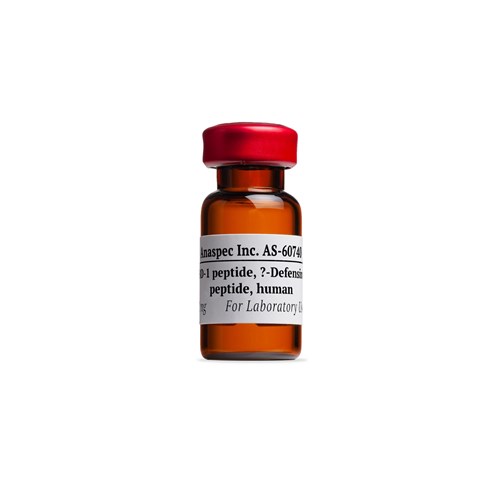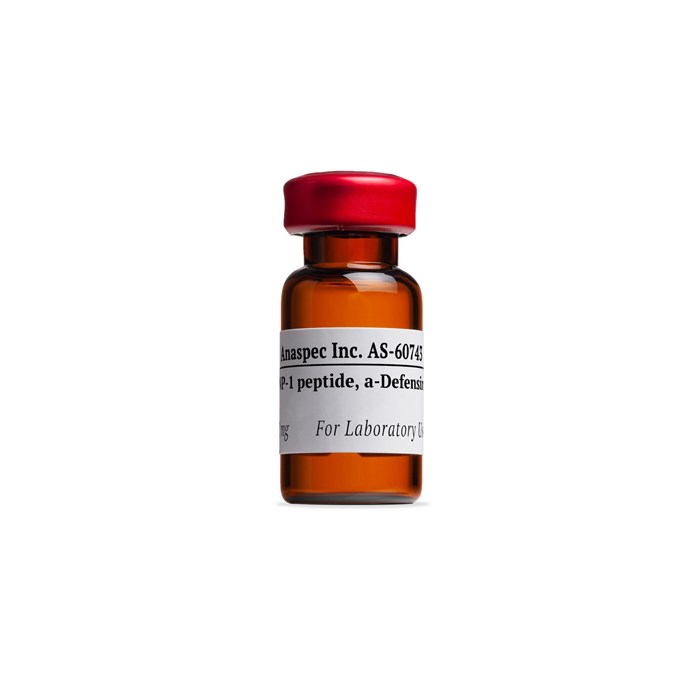HNP-1, a-Defensin-1, Human Neutrophil Peptide-1 - 0.1 mg
- Cat.Number : AS-60743
- Manufacturer Ref. :
-
Availability :
In production
Alternative choices
Mammalian defensins are abundant in the cytoplasmic azurophilic granules of neutrophils, Paneth cells of the small intestine and some macrophages. Human a-defensin-1 (HNP-1) is a peptide possessing both broad antimicrobial (both Gram-positive and Gram-negative bacteria) and cytotoxic activities. HNP-1 reduces adenoviral infection by more than 95%.
Specifications
| Chemistry | |
| Sequence one letter code |
|
|---|---|
| Sequence three letter code |
|
| CAS registry number |
|
| Molecular Formula |
|
| Molecular Mass/ Weight |
|
| Modification | |
| Conjugation |
|
| Quantity & Purity | |
| Purity |
|
| Storage & stability | |
| Form |
|
| Storage Conditions |
|
| Activity | |
| Biomarker Target | |
| Research Area | |
| Sub-category Research Area | |
| Usage |
|
| Source | |
| Source / Species |
|
| Codes | |
| Code Nacres |
|
Downloads
You may also be interested in the following product(s)


Citations
Cationic antimicrobial peptides disrupt the Streptococcus pyogenes ExPortal
Mol Microbiol . 2012 Jul 11 ; 85(6) 1119 | DOI : 10.1111/j.1365-2958.2012.08163.x
- LA. Vega
- et al
Burkholderia cenocepacia zinc metalloproteases influence resistance to antimicrobial peptides.
Microbiology. . 2009 Jun 18 ; 155(Pt9) 2818 | DOI : 10.1099/mic.0.028969-0
- C. Kooi
- PA. Sokol
Candida albicans Mucin Msb2 Is a Broad-Range Protectant against Antimicrobial Peptides
Antimicrob Agents Chemother . 2013 Aug 01 ; 57(8) 3917 | DOI : 10.1128/AAC.00862-13
- M. Swidergall
- et al
Candida albicans mucin Msb2 Is a broad-tange protectant against antimicrobial peptides.
Antimicrob Agents Chemother . 2013 Aug 01 ; 57(8) 3917 | DOI : 10.1128/AAC.00862-13.
- M. Swidergall
- et al
Chlamydial plasmid-encoded virulence factor Pgp3 neutralizes the antichlamydial activity of human cathelicidin LL-37
Infect Immun . 2015 Sep 28 ; 83(12) 4701 | DOI : 10.1128/IAI.00746-15
- S. Hou
- et al
Strategies for the identification of arginine ADP-ribosylation sites.
J Proteomics . 2011 Dec 10 ; 75(1) 169 | DOI : https://doi.org/10.1016/j.jprot.2011.07.003
- S. Laing
- et al
